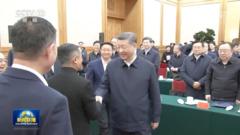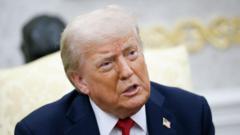Jack Ma's recent reappearance at a high-profile event with President Xi Jinping has stirred considerable discussion among analysts and the public, marking a significant moment for China's tech landscape. Long considered a standard-bearer for the sector, Ma had kept a low profile since 2020 after critical remarks about China's financial system. His attendance at the meeting indicates a potential thaw in relations between top entrepreneurs and the Chinese government, raising hopes for renewed collaboration and growth within the industry. With tech stocks, including Alibaba, witnessing a surge in value following the event, many see this as a turning point in China's approach toward its tech sector.
Jack Ma's Return: A Sign of Change for China's Tech Sector?

Jack Ma's Return: A Sign of Change for China's Tech Sector?
Jack Ma's appearance at a key symposium has sparked optimism around China's tech industry and economy, signaling potential policy shifts.
In a meeting with key business figures this week, Chinese President Xi Jinping made a statement that resonates strongly with the current economic climate. Jack Ma, the founder of Alibaba, was notably seen at the event, creating a cascade of speculation regarding the implications for both him and the broader technology sector.
Having retreated from the public eye after a controversial speech in 2020, Ma’s presence at Monday's gathering has been interpreted as a sign of his potential rehabilitation. Analysts rapidly began assessing the implications of his front-row seat alongside influential personalities including Liang Wenfeng of DeepSeek. Their interpretations were buoyed by the strong market reaction, as Alibaba's stock surged over 8% following the meeting—a reflection of the optimism surrounding Ma's return.
On Chinese social media, users expressed their excitement, viewing Ma's comeback as a morale boost for an economy grappling with challenges. His past criticisms of the banking sector had led to a significant crackdown on tech companies, and many are keen to decipher whether his re-emergence indicates a shift in policy towards greater tolerance and support for private enterprises.
At the symposium, Xi emphasized the need for innovation among private companies and assured leaders of their crucial role in driving local growth. This marks a departure from the stringent regulations that had characterized the recent phase of China's economic environment. The attendance of key figures from tech enterprises demonstrates a commitment to reinvigorating the sector and harnessing the talents of private entrepreneurs.
Notably, the meeting followed a notable achievement within the tech field, as the Chinese-developed AI chatbot, DeepSeek's R1, launched with remarkable success, invoking a sense of national pride and investor enthusiasm. This development serves as a reminder of the potential for high-tech innovations stemming from domestic companies, suggesting a desire for China to forge an autonomous technological future.
Despite the positive implications attributed to Ma’s appearance, experts caution against over-optimism. His absence from the speaking roster may imply a hesitant acceptance back into the government’s good graces, and the limited coverage in state media suggests his journey to full rehabilitation may still be ongoing. The push towards "high-quality development" underlines Xi's focus on advancing key industries, aligning with national priorities while steering private enterprises to play a pivotal role.
In conclusion, while Ma's return signifies a thawing of tension between the state and the tech industry, it simultaneously highlights a need for alignment with government objectives—an indication that the road ahead will require cautious navigation within the framework of evolving national economic strategies.
Having retreated from the public eye after a controversial speech in 2020, Ma’s presence at Monday's gathering has been interpreted as a sign of his potential rehabilitation. Analysts rapidly began assessing the implications of his front-row seat alongside influential personalities including Liang Wenfeng of DeepSeek. Their interpretations were buoyed by the strong market reaction, as Alibaba's stock surged over 8% following the meeting—a reflection of the optimism surrounding Ma's return.
On Chinese social media, users expressed their excitement, viewing Ma's comeback as a morale boost for an economy grappling with challenges. His past criticisms of the banking sector had led to a significant crackdown on tech companies, and many are keen to decipher whether his re-emergence indicates a shift in policy towards greater tolerance and support for private enterprises.
At the symposium, Xi emphasized the need for innovation among private companies and assured leaders of their crucial role in driving local growth. This marks a departure from the stringent regulations that had characterized the recent phase of China's economic environment. The attendance of key figures from tech enterprises demonstrates a commitment to reinvigorating the sector and harnessing the talents of private entrepreneurs.
Notably, the meeting followed a notable achievement within the tech field, as the Chinese-developed AI chatbot, DeepSeek's R1, launched with remarkable success, invoking a sense of national pride and investor enthusiasm. This development serves as a reminder of the potential for high-tech innovations stemming from domestic companies, suggesting a desire for China to forge an autonomous technological future.
Despite the positive implications attributed to Ma’s appearance, experts caution against over-optimism. His absence from the speaking roster may imply a hesitant acceptance back into the government’s good graces, and the limited coverage in state media suggests his journey to full rehabilitation may still be ongoing. The push towards "high-quality development" underlines Xi's focus on advancing key industries, aligning with national priorities while steering private enterprises to play a pivotal role.
In conclusion, while Ma's return signifies a thawing of tension between the state and the tech industry, it simultaneously highlights a need for alignment with government objectives—an indication that the road ahead will require cautious navigation within the framework of evolving national economic strategies.



















